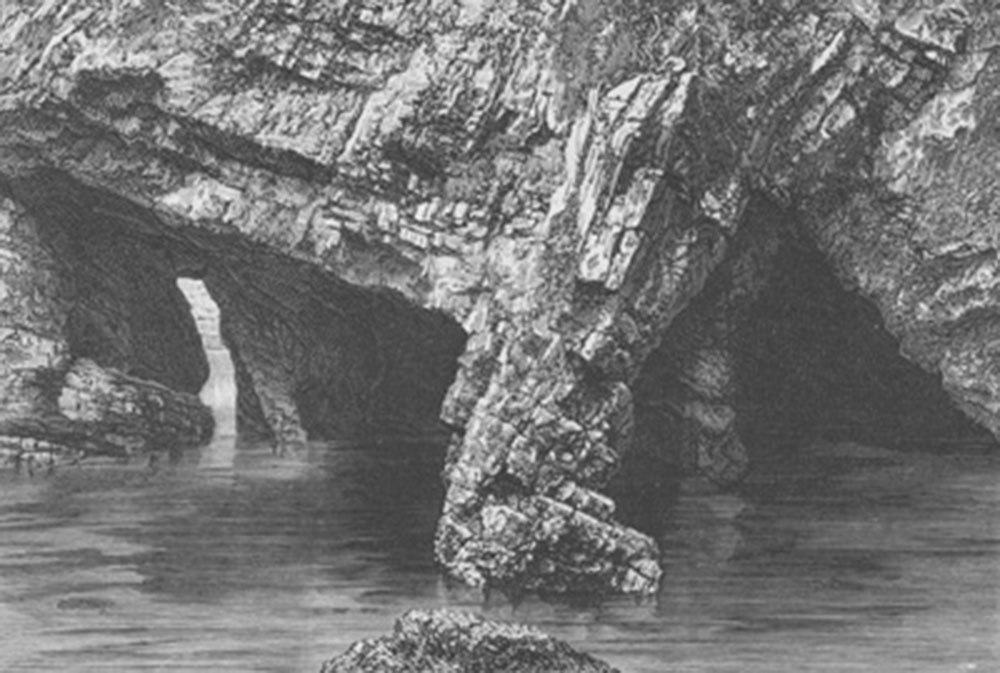Lough Swilly - Irish Pictures (1888)
From Irish Pictures Drawn with Pen and Pencil (1888) by Richard Lovett
Chapter VIII: The Donegal Higlands … continued
« Previous Page | Start of Chapter | Book Contents | Next Chapter »
After a fine ride from the Lackagh River, Mulroy Bay, in some respects the most interesting of all these fjords, is reached. Unlike Sheephaven or Lough Swilly, it is broken up by a multitude of islands, affording ever-varying and ever-fresh views. Skilful boatmen are to be had, and very enjoyable sails can be obtained on the bay. As the Atlantic is neared the shores get lower and more rocky and bare. At the extremity of the eastern headland is the little fishing village of Ballyhoorisky, inhabited by a sturdy race of fishermen, capital boatmen, ready when occasion serves to sail on the bay, to visit Tory Island, and for any other trip. One drawback is that they will chatter away in Irish to one another, and as that language sounds singularly inharmonious to a Saxon ear, the inability to understand what is said is unrelieved by sounds that in themselves are pleasing.
On one occasion the writer found himself in this out-of-the-world nook. He had come hoping for a fine day, and a long sail to Tory Island. But alas! Nature was in an unkindly mood, donning grey skies, and letting fall a drizzling rain. Beyond the village broad spurs of rock covered with heaps of sand jut out into the ocean, which was breaking upon them with considerable force. Just as we left the village a procession came down the lane. At the head walked a man in his best apparel, bearing aloft a huge wooden cross, then followed a plain coffin borne by four men; and close after this, walking two by two, all in their best "dress, came what must have been nearly the whole population of the village. The funeral was plain and very touching from its absolute simplicity. It was one of those sudden unexpected incidents that give at once the charm and the value to travel, striking those deeper chords that vibrate in all hearts. Here too Death claimed his victims, here too love and sympathy and kindliness flourished. No doubt even at Ballyhoorisky the bonds of custom are strong, and some followed, possibly, on this account only; but the signs of neighbourly fellowship and interest were predominant. As the little procession wended its way over the waste, the humble cottages, the varied and subdued dresses of the mourners, the yellow sand-heaps, the bare rocks, upon which the Atlantic surges were hurling themselves in a heavy fringe of snow-white surf, stood out in sharp contrast against the clear background of the steel-grey waters stretched out to the distant horizon. Over all hung the dull sky, harmonizing well with the scene of mourning, the combination uniting to form a picture that will live long in the memory by reason of its blending together the uncommon and beautiful in Nature with the too common manifestation of human frailty and sorrow.
The country from Ballyhoorisky to Fanad and Port Salon on Lough Swilly is interesting, and Lough Swilly's charms need no panegyric. In the neighbourhood of Port Salon are the noted caverns in the cliffs which form the Seven Arches, and a little further north is Fanad Head, confronted on the opposite shore of the lough by Dunaff Head. From Port Salon in the summer a steamer runs down the lough, passing Buncrana and Rathmullan to Fahan, where again the rail is touched. The scenery along the eastern shore of the lough, and notably from Buncrana to Dunaff Head, by way of the Gap of Mamore, is bold and attractive to the pedestrian. But it is time we turned our steps towards Derry and Belfast, the great industrial centres of the north of Ireland.
END OF CHAPTER VIII.
« Previous Page | Start of Chapter | Book Contents | Next Chapter »

